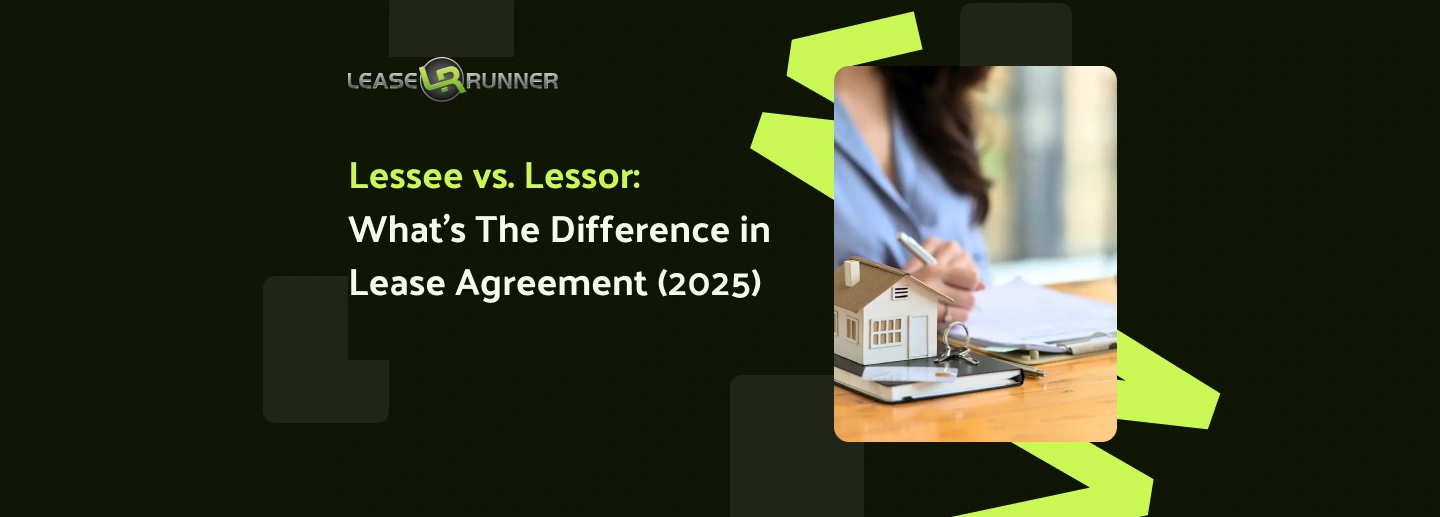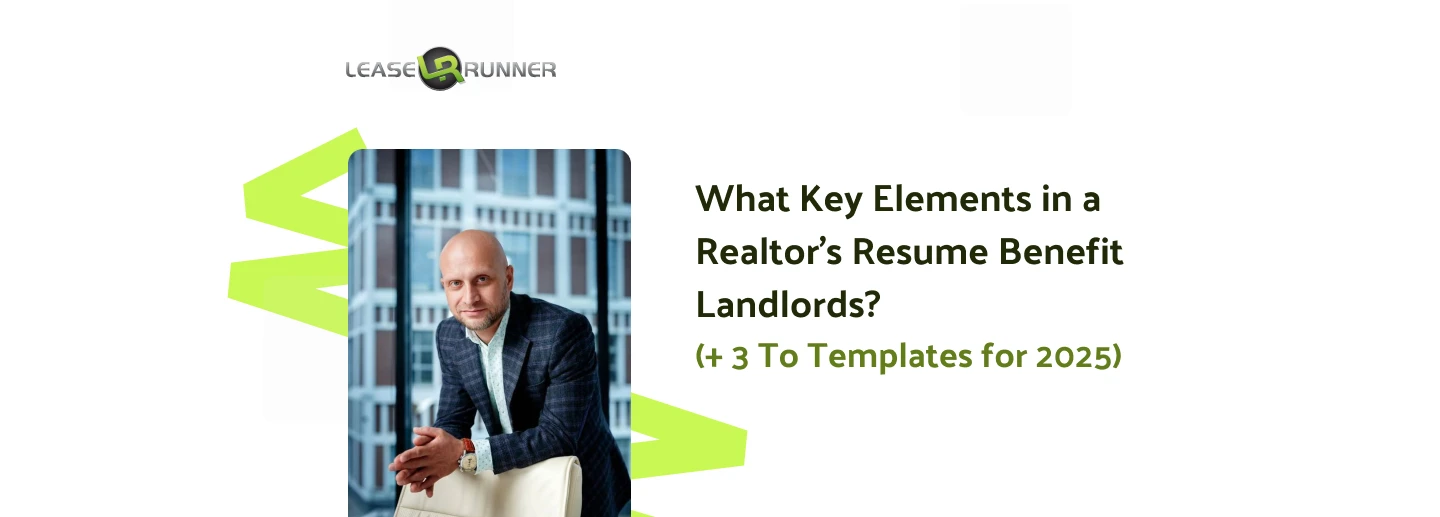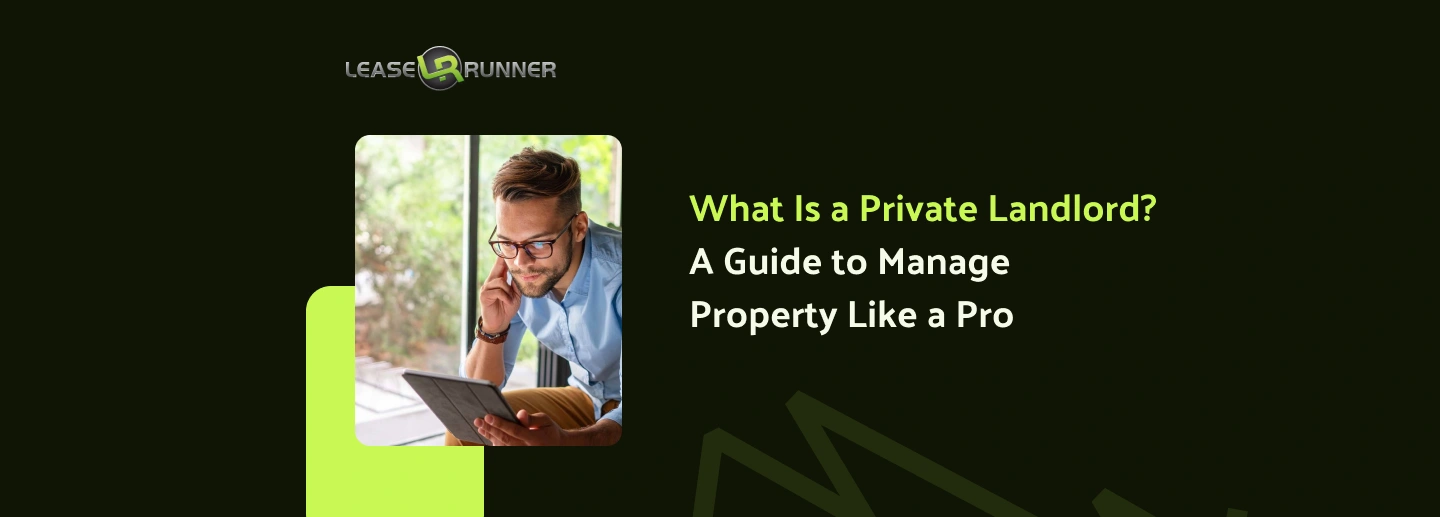Understanding lessee vs. lessor is crucial for anyone dealing with property rentals or lease contracts. We at LeaseRunner understand that knowing the difference between a lessor and a lessee avoids confusion, legal issues, and financial loss.
This article provides all the lessee and lessor definition, their position in a lease, legal responsibilities, the most common pitfalls, and real-life examples. This article will assist you in drawing more effective lease agreements and safeguarding your interests if you are a tenant, first-time landlord, experienced landowner, or property manager.

Quick Facts: Lessee vs. Lessor
What is a Lessor?
A lessor is a person or organization that possesses an asset or property and gives another person the right to use it for a specified period of time, in return for some type of compensation.
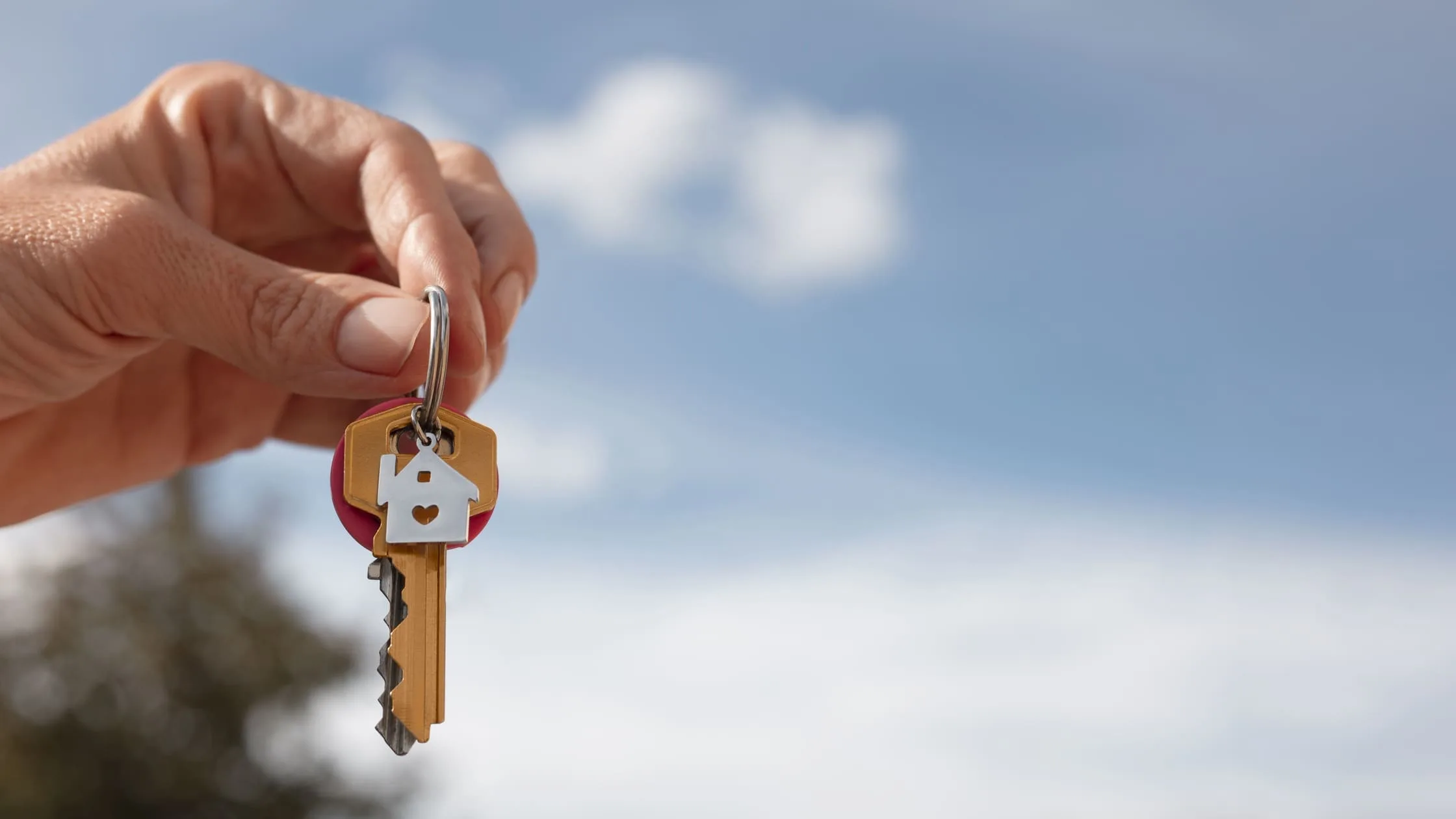
In the real estate context, the lessor is also commonly referred to as the landlord. In any lessor and lessee situation, the name of the lessor shows up on forms as the owner of the property or an accepted agent acting for the owner.
The lessor has an important part in the lease relationship. Crucially, the lessor holds a dominant role in defining the initial terms and conditions of the lease agreement, as they own the property and set the rules for its use.
For instance, if you rent a flat, the lessor is the owner or company of the building that rents it to you. The lessor has the legal title of the property and can lease it to someone else.
Becoming a landlord or lessor comes with quite a lot of responsibilities. The following are some of the lessor's major duties of this role:
- Offer a Habitable Property: The property has to be clean, safe, and ready for use by the lessee. That implies that all the systems, such as heating, plumbing, and electric wiring, have to be in good condition. For example, before a tenant moves into a rental house, the lessor should inspect and fix any leaks, test the heater, and make sure locks function on all doors and windows.
- Keep the Property in Good Condition: The lessor is required to perform routine maintenance and repairs on the building, as well as key systems. If the roof leaks when it rains, the lessor ought to repair it. In the same manner, if the wiring is poor, the lessor must repair it. These are usually stipulated in the lessor and lessee contract and in local government regulations.
- Be in Compliance with State and Local Laws: The lessor must comply with all the rental laws applicable, such as fair housing laws, health and safety codes, and eviction laws. For instance, the lessor cannot discriminate against tenants on the basis of protected classes and also needs to comply with legal procedures to evict a tenant.
- Deliver Possession: The lessor has to deliver possession of the property to the lessee on the scheduled move-in date. In case of delay in preparing the property, the lessee can withhold payment of rent or terminate the lease.
Interest in a full detailed checklist? Check out these 10 essential things to do when you start out as a new lessor or landlord.
What is a Lessee?
A lessee is an individual or company that acquires the occupation and use of property or an asset on lease. In real estate, the tenant is a lessee. In any lessor and lessee contract, the lessee is the entity that enters the lease and promises to abide by the rules.
The lessee is in charge of lots of things, some of lessee's major responsibilities include:
- Pay Rent: The lessee remits the rent on time and in full as the lease agreement dictates. For instance, if the rent is payable on the first day of every month, the lessee ought to remit it on that date to avoid a penalty or eviction.
- Adhere to Lease Terms: The lessee should adhere to all the terms of the lease. This may include no smoking, no pets without permission, and tidying the premises. If loud music after 10 pm is prohibited in the lease, the lessee should abide by this provision.
- Report Problems: If anything gets spoiled, the lessee should report it to the lessor immediately. For instance, if the winter heating is not functional, then the lessee should report it to the landlord immediately. This helps the lessor get the problem rectified early and keeps the property safe.
- Grant Access for Repairs: The lessee should provide the lessor or their representatives with entry to the property for repairs, provided that they provide good notice. In case the tenant wants to repair a leaky faucet, the lessee should provide access at the time specified.
What Does “Non-Lessee” Mean?
Non-lessee is any individual who is residing or occupying a rental property not shown as a lessee on the lease agreement. Knowing what non-lessee entails prevents confusion and legal conflicts in any lessor and lessee relationship.
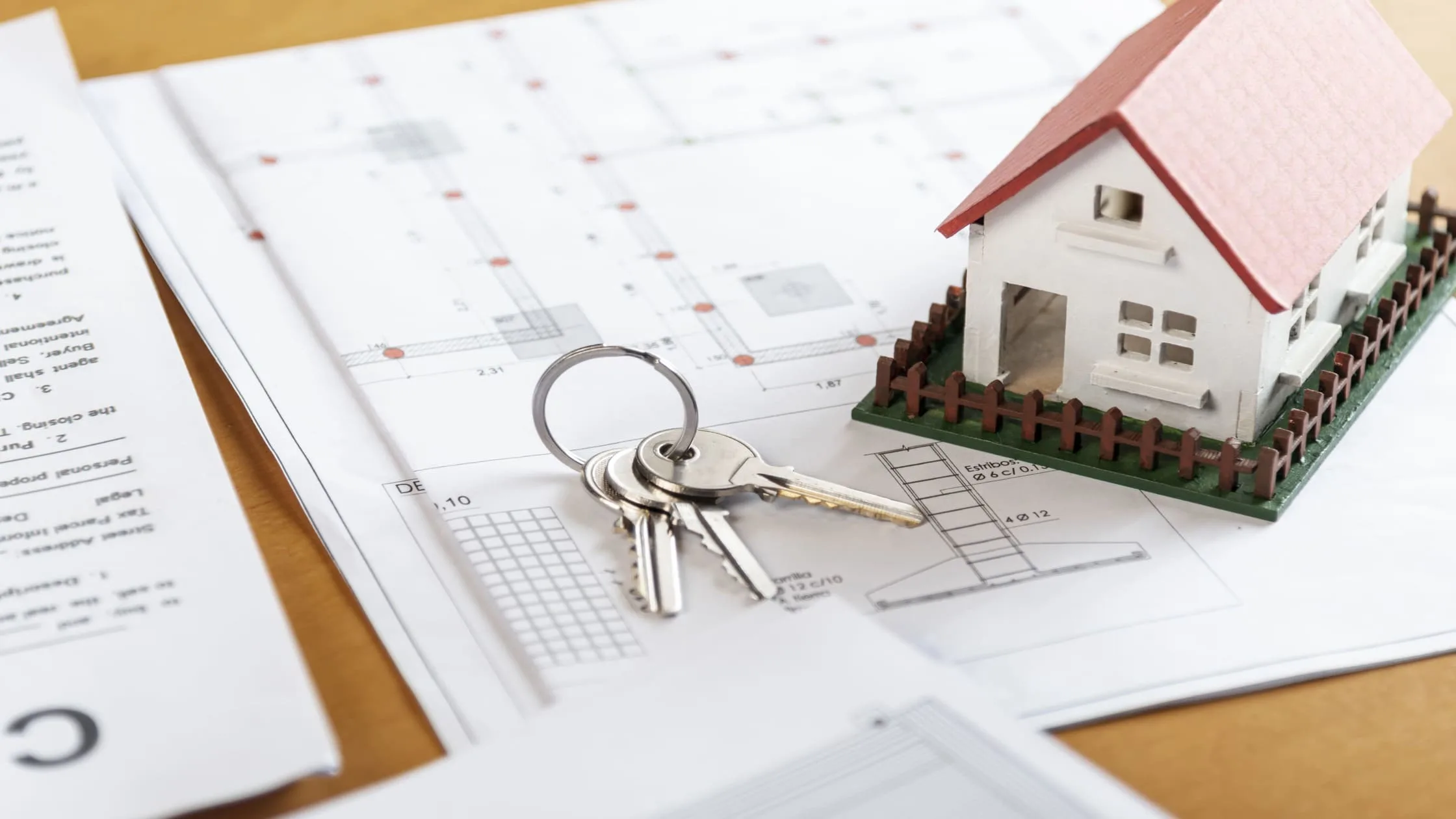
Examples of Non-Lessees
Let us consider who would qualify as a non-lessee in a lease:
- Authorized Occupants: Individuals who the lease permits to reside within the unit but are not liable for the lease. For instance, a spouse or child of a tenant may reside in the apartment as an authorized occupant but is only liable for rent and for damages if the individual is named as the lessee. When the partner shatters a window, the lessee repairs it.
- Guests: These are short-term visitors who aren’t listed on the lease. If a guest stays too long, the tenant may need permission from the landlord. Otherwise, it could count as a lease violation for having an unauthorized occupant.
- Roommates: If a roommate is not mentioned in the lease, he or she is a non-lessee. For example, if John signed the lease but Mike, his friend, moves in afterward without being mentioned, Mike is a non-lessee. Mike will have no legal rights in the event of a disagreement or the end of the lease.
- Squatters: An individual who lives on the property without any permission or lease is not a leaseholder. If the friend overstays after the end of the lease or an individual moves in without notice, they are squatters and can be ejected by the lessor.
How to Protect Your Lease From Non-Lessee Hazards?
You need to protect your property and clarify roles in every lessor and lessee contract
- List All Adults: Always put all adult residents on the lease as lessees or authorized residents. That way, everyone is liable for rent and damage.
- Use Clear Lease Language: State who pays rent, who pays damages, and who needs to obey rules clearly.
- Enforce the Lease: If a cause of trouble that isn't an injury, the lessor can sue to evict them.
A good lease must always contain who the lessee is, who the occupant is, and what both of them must do. This prevents disputes and ensures landlord and tenant rights.
Key Differences Between Lessee and Lessor
It is important to know what distinguishes a lessee and a lessor to achieve a successful lease agreement. Both have implied obligations and rights. This is an in-depth examination of what distinguishes them in each lessor and lessee agreement.
Comparison Table: Lessee vs Lessor
Let's break down these key distinctions further, starting with the fundamental difference in their relationship to the property.
Ownership vs temporary rights
The true distinction between lessee and lessor initially is ownership.
The lessor is the legal owner of the property and retains title to the asset, home, or apartment. As an example, if you rent a home, then the landlord is the lessor but still the legal owner while you occupy it.
In leasing a vehicle, the lessor would be the finance company owning the vehicle, while you are allowed to drive it during the term of the lease.
The lessee, however, receives temporary rights. The lessee can use and occupy the property but never owns the property. For instance, in commercial leasing, a company (lessee) leases space in an office building from a building owner (lessor). The company can occupy the office, but cannot sell the office or make any significant changes to the property.
Obligation to pay vs obligation to maintain
The other important difference between the lessor and lessee is in their fundamental obligations. The fundamental obligation of the lessee is to make prompt payment of rent and abide by the terms of the lease.
For instance, if the lease stipulates that rent should be paid on the first day of every month, the lessee should do so. The lessee should also maintain the premises in good condition and avoid subjecting them to destruction.
The primary responsibility of the lessor is to take care of the property and obey all the laws. For instance, if a plumbing problem occurs, the lessor has to organize repairs immediately. In all lessor and lessee contracts, these duties are enumerated clearly in order to prevent misunderstandings.
Responsibilities in lease creation and enforcement
When signing and executing the lease, the lessor does so. The lessor drafts the lease, lays down the terms, and ensures that the agreement meets the state and local requirements. For instance, the lessor indicates whether or not pets can be kept and whether or not smoking is permitted. The lessee should read the lease, agree to the terms, and sign.
If the lease is broken by one party, the other can sue. For example, if the lessee does not pay rent, the lessor may evict. If the lessor fails to do the repairs that are required, the lessee may withhold rent or break the lease.
Legal Obligations as The Lessor
Each lessor has significant legal responsibilities to maintain a property under lease valid and equitable manner. A knowledge of these landlords vs tenants’ responsibilities averts controversies and safeguards both sides of the lessor and lessee relationship.

1. Property Upkeep
The property is always to be rendered secure and habitable by the lessor. For instance, the lessor ought to have heaters repaired, fix electric problems, and seal leaks in a timely manner. For instance, if there is a leak reported on the roof, the lessor ought to call a roofer and have it repaired right away.
If the furnace malfunctions during winter, the lessor must arrange for repairs promptly so that the property can be rendered habitable. Common areas, like corridors or common washing facilities, in multi-residential properties must be maintained by the lessor.
2. Delivering Possession
It is the lessor's duty to facilitate access to the lessee on the move-in date set. An example is if the lease begins on June 1, the lessor should be ready to make keys available and set up the unit for the lessee.
If the property is not yet ready to be occupied—such as in the case of a partial repair or another tenant, will not vacate—then the lessee has the luxury of postponing the rent, seeking redress, or even rescission of the lease. This obligation is a primary component of all lessor and lessee contracts.
3. Complying with Laws
There are many things that the landlord or the lessor cannot do to avoid breaking the laws. Therefore, they must also understand and comply with all local and state rental laws. These include health and safety codes, fair housing codes, as well as legal eviction processes. For instance, the lessor cannot deny tenancy due to family status, religion, or race.
When the tenant is late in paying rent, the lessor must serve legal notices and perform the proper procedures before beginning the eviction. Implying otherwise will draw lawsuits or fines.
In case the lessee does not comply with the above duties, the lessee may report violations to local authorities, withhold payment of rent, or consult a lawyer. Knowing what the lessor is obligated under the lease contract and how they are bound by law helps maintain leases organized and justifiable to everyone.
Lessee Rights and Responsibilities
All the lessees have explicit duties and entitlements in a lessee and lessor contract. Being aware of them prevents issues and maintains the rental relationship functioning smoothly.

1. Rent Payment Responsibility
The most fundamental duty of the lessee is making rent payments on time and in full. For instance, if the lease indicates that rent has to be made on the first of each month, the lessee should see to it that it is delivered before then.
When the lessee is late in paying, the lessor can impose a late charge or eject. If repeatedly late in a worst-case scenario, the lessor can terminate the lease prematurely. That is why it is very crucial to understand who the lessee under a lease agreement is, because only the lessee is responsible for paying rent.
2. Right to Quiet Enjoyment
The lessee also has the right to peacefully occupy the property without disturbance from the lessor. This is referred to as the right to quiet enjoyment. For instance, the lessor cannot enter the flat at all without appropriate notice, except in an emergency.
If the repairs are to be conducted by the lessor, then they must provide at least 24 hours' notice prior to entry. Should the lessor break in and enter without notice, then the lessee may complain or seek compensation. This protection exists in all lessor and lessee contracts.
3. Reporting Repairs or Violations
If the property gets damaged, the lessee is required to inform the lessor in a timely manner. For instance, if the water heater is no longer working, the lessee must inform or write to the lessor in a timely manner.
This makes the lessor repair things before issues can occur. If the lessee discovers something hazardous or another tenant violates the lease, they must inform that as well. This makes the property secure and encourages everyone to abide by the landlord-tenant laws.
Common Clauses in Lessor and Lessee Agreements
All leases need definite terms to safeguard the lessee and the lessor. The most usual provisions are:
1. Rent payment terms
The lease must specify the rent value, payment date, and mode of payment. The lease must also define late charges and consequences of late rent payments.
2. Maintenance and repairs
The agreement between lessor and lessee should also outline who repairs what. An instance would be that the lessor repairs pipes, yet the lessee replaces light bulbs.
3. Entry and notice
The lease shall indicate the amount of notice the lessor shall give before entering the property. This is a measure of respect for the privacy of the lessee, but also acceptable under law.
4. Termination and renewal
The lease must state what to do if the agreement. It must detail notice periods and penalty terms for ending the lease early.
Examples of Lessor vs Lessee in Real Estate
Lessor and lessee examples better explain these terms in real life.
Example 1: Single-family home rental
A homeowner (lessor) rents out a house to a family (lessee). The family pays monthly rent and follows the lease rules. The owner maintains the roof and plumbing.
Example 2: Multi-unit building lease
An apartment building owner (lessor) leases a unit to a college student (lessee). The student pays rent, reports repairs, and follows building rules. The owner handles common area cleaning and major repairs.
Example 3: Commercial property
A company (lessor) leases office space to a startup (lessee). The startup pays rent, keeps the space clean, and follows all lease terms. The company maintains the building and ensures compliance with safety codes.
Common Misunderstandings Landlords Have with Lessee vs. Lessor
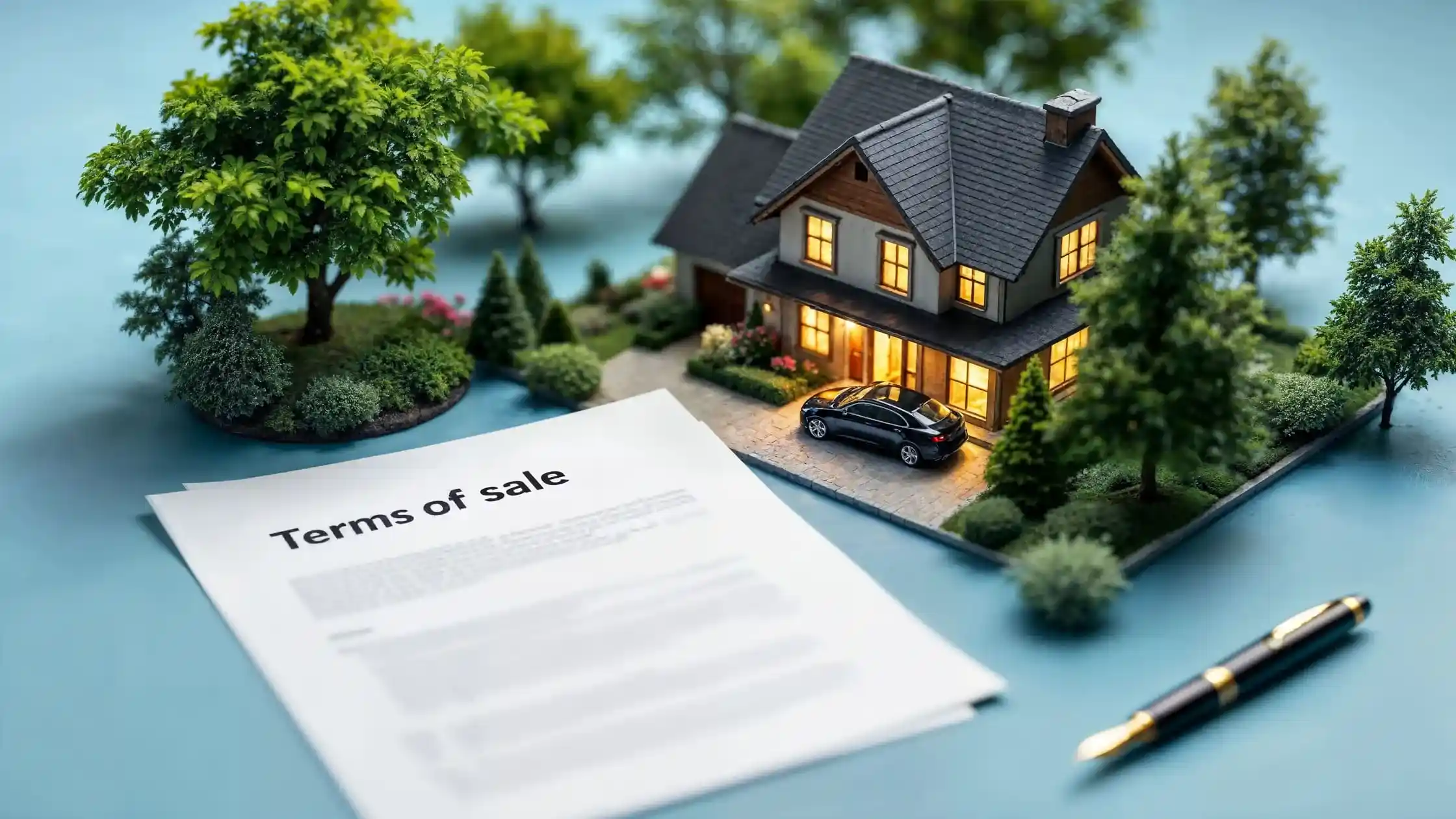
First-time landlords often make mistakes about lessee vs lessor roles. Here's how to avoid them:
Thinking Lessee Means Someone Who Manages
Some believe the lessee manages the property. In fact, the lessee only occupies and uses it. The lessor is still responsible for major maintenance and legal duties.
Confusing Lessor Obligations with Property Managers
A property manager acts as an agent for the lessor but does not own the property. The lessor keeps all legal obligations, even if a manager handles daily tasks.
Not Defining Terms Clearly in the Lease
Unclear lease language leads to disputes. Always define who the lessor is and who the lessee is in the agreement. Use clear terms for all responsibilities and rights.
Prevention tips for first-time landlords:
- Use a detailed lease template from LeaseRunner.
- List all adult tenants as injured.
- Explain who pays for what and who handles repairs.
- Review local laws about landlord vs tenant responsibilities.
Conclusion
Understanding lessee vs lessor is the first step to a successful lease agreement. The lessor owns the property and sets the terms. The lessee pays rent and follows the rules. Clear roles, detailed agreements, and good communication prevent most rental problems.
At LeaseRunner, we help landlords and tenants create strong, legal lease agreements that protect everyone's interests. Whether you're renting out your first home or signing a new lease, knowing the difference between lessee and lessor ensures a smooth, stress-free rental experience.
FAQs
Q1. What are the lessee and lessor's meanings?
The lessor is the property owner who rents out the asset. The lessee is the person or business who rents and uses the asset.
Q2. Who is the lessor in a lease agreement?
The lessor is always the owner or authorized agent who grants the right to use the property.
Q3. Who is the lessee in a lease agreement?
The lessee is the tenant or business that rents and occupies the property.
Q4. Is the landlord the lessor or lessee?
The landlord is the lessor. The tenant is the lessee.
Q5. What does non-lessee mean?
A non-lessee is anyone using the property who is not named on the lease, like an unauthorized roommate or squatter.
Q6. Who is the lessor and who is the lessee in commercial leases?
The property owner is the lessor; the business renting the space is the lessee.
